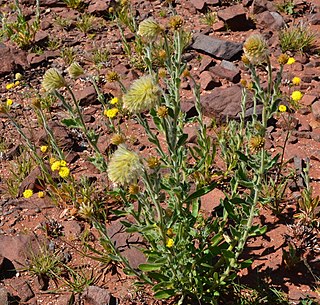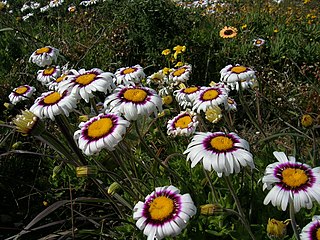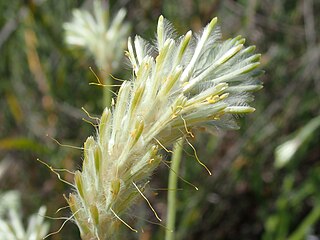
Bulbine bulbosa, commonly known as bulbine lily, native leek, golden lily, or native onion, is a species of flowering plant in the family Asphodelaceae and is endemic to Australia. It is a perennial herb with thick roots, channelled leaves, and yellow flowers with hairy stamen filaments.

Ptilotus is a genus of approximately 125 species of flowering plants in the family Amaranthaceae, and is endemic to Australia, apart from Ptilotus conicus that also occurs in Malesia. Plants in the genus Ptilotus are annual or perennial herbs or shrubs with usually hairy spikes of compact spherical, oval or cylindrical flowers.

Felicia filifolia is a Southern African member of the family Asteraceae. It is a hardy, sprawling shrub growing to about 1 metre tall. Leaves are narrow and clustered along the twigs. When blooming it is densely covered in flowerheads with ray florets that are pink-mauve to white and disc florets that are yellow. In the wild, flowers can be found August to December.

Ptilotus exaltatus, more commonly known as pink mulla mulla, is an erect annual herb endemic to large parts of arid and semi-arid Australia. It grows throughout most areas of Australia except the Nullarbor Plain, occurring geographically above a line drawn from Perth to Esperance. The species was first observed and described in 1810, and comprehensively catalogued in 1971.

Ptilotus clementii, commonly known as tassel top, is a native Australian annual herb growing to between 0.3 and 1 metre high. Nodding, green flower spikes are produced between March and November in the species' native range.

Ptilotus nobilis, commonly known as yellow tails, is an annual or short-lived perennial herb of the family Amaranthaceae. It is found in arid regions of South Australia, southern and eastern Northern Territory, western Queensland and western New South Wales.
Karl Suessenguth was a German botanist.

Felicia echinata, commonly known as the dune daisy or prickly felicia, is a species of shrub native to South Africa belonging to the daisy family. It grows to 1 m (3.3 ft) high and bears blue-purple flower heads with yellow central discs. In the wild, it flowers April to October.
Hansjörg Eichler was a German-born botanist, educated in Europe, who worked in Europe and Australia, and whose greatest contribution was to Australian botany.

Felicia elongata is a perennial plant of up to 40 cm high that is assigned to the family Asteraceae. It has stiff, oval, opposing leaves with one distinctive vein and entire margin. The 5 cm (2 in) wide flower heads are very conspicuous in colour, white with a dark purple zone at the base of the ray florets and an orange-yellow disc. Flowering occurs from late August to September, or if the rains arrive late, sometimes October. It is a rare species that is restricted to the Saldanha Bay area. It is sometimes called Saldanha felicia or tricolour felicia in English, and driekleurblommetjie in Afrikaans.
Felicia westae is a sparsely branched shrub growing up to 40 cm tall, that is assigned to the family Asteraceae. The lower parts of the stems have lost their leaves and the upper part has many crowded, upwardly angled and curved, alternate leaves pressed against the stem, with the edges curled inward. The flower heads form at the tips of the branches, each about 31⁄3 cm across, with about twenty purplish blue ray florets surrounding many yellow disc florets. It is only known from a small area in the Eastern Cape province of South Africa.

Ptilotus polystachyus is a perennial herb in the Amaranthaceae family.
Ptilotus actinocladus is a species of flowering plant in the family Amaranthaceae and is endemic to inland Western Australia. It is a prostrate annual herb with a central stem and radiating lateral stems, linear to lance-shaped stem leaves, pink spherical or cylindrical spikes of flowers with long, silky hairs, and four fertile stamens.

Ptilotus aervoides, commonly known as mat mulla mulla, is a species of flowering plant in the family Amaranthaceae and is endemic to western Australia. It is a prostrate, mat-forming annual or short-lived perennial herb, its stems densely hairy at first, egg-shaped to spatula-shaped stem leaves, dense spikes of hairy creamy-green flowers with two or three fertile stamens.

Ptilotus albidus is a species of flowering plant in the family Amaranthaceae and is endemic to inland Western Australia. It is a compact perennial shrub with linear leaves, spherical spikes of white flowers and dull brown seeds.
Ptilotus alexandri is a species of flowering plant in the family Amaranthaceae and is endemic to the far west of Western Australia. It is an erect, annual herb with spatula-shaped leaves, spikes of pink flowers and glossy black seeds.
Ptilotus andersonii is a species of flowering plant in the family Amaranthaceae and is endemic to a restricted area of Western Australia. It is a prostrate, hairy, perennial herb with a spatula-shaped to lance-shaped leaves at the base of the plant, lance-shaped cauline leaves, and pink, oval spikes of flowers with two fertile stamens.

Ptilotus aphyllus is a species of flowering plant in the family Amaranthaceae and is endemic to the a small area of inland Western Australia. It is a leafless perennial, except when young, and spikes of purple flowers fading to pink and pale orange.

Ptilotus appendiculatus is a species of flowering plant in the family Amaranthaceae and is endemic to the north of Western Australia. It is a prostrate perennial herb with egg-shaped leaves and spikes of pink flowers.












